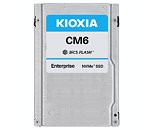- Joined
- Oct 9, 2007
- Messages
- 47,895 (7.38/day)
- Location
- Dublin, Ireland
| System Name | RBMK-1000 |
|---|---|
| Processor | AMD Ryzen 7 5700G |
| Motherboard | Gigabyte B550 AORUS Elite V2 |
| Cooling | DeepCool Gammax L240 V2 |
| Memory | 2x 16GB DDR4-3200 |
| Video Card(s) | Galax RTX 4070 Ti EX |
| Storage | Samsung 990 1TB |
| Display(s) | BenQ 1440p 60 Hz 27-inch |
| Case | Corsair Carbide 100R |
| Audio Device(s) | ASUS SupremeFX S1220A |
| Power Supply | Cooler Master MWE Gold 650W |
| Mouse | ASUS ROG Strix Impact |
| Keyboard | Gamdias Hermes E2 |
| Software | Windows 11 Pro |
KIOXIA America, Inc. (formerly Toshiba Memory America, Inc.), the U.S.-based subsidiary of KIOXIA Corporation, today announced that its lineup of PCIe 4.0 NVMeTM enterprise solid state drives (SSDs) has achieved PCI-SIG compliance for PCIe 4.0 and University of New Hampshire InterOperability Laboratory (UNH-IOL) certification. KIOXIA's CM6 Series successfully passed interoperability tests at the August 2019 PCI-SIG Compliance Workshop - the first workshop to include official PCIe 4.0 specification tests. KIOXIA America will be on hand at Supercomputing 2019 later this month to showcase new levels of flash performance enabled by its CM6 Series SSDs.
The first company to publicly demonstrate PCIe 4.0 SSDs, KIOXIA has established itself as a leader in developing PCIe 4.0 NVM Express SSDs and continues to push the limits of flash storage performance. The CM6 Series brings planned performance improvements of 3x over its PCIe 3.0 predecessors and is 12x faster than SATA drives. KIOXIA's lineup of Gen4 PCIe SSDs also includes the CD6 Series, which is targeted to cloud and scale-out environments.

Key Features:
PCI-SIG hosts Compliance Workshops several times a year in various locations worldwide, giving members the opportunity to test and validate their products before entering the field. Compliance testing is completed against both PCI-SIG maintained systems and other leading manufacturers of PCI products. As the leading testing and certification lab for NVMe technology and software, the UNH-IOL provides conformance and interoperability testing across various operating systems, drivers, and hardware platforms, as well as PCIe SSDs and PCIe-enabled servers. "The SSD market is quickly moving to NVM Express technology, and standards compliance is critical to ensure smooth adoption," added Toledo.
View at TechPowerUp Main Site
The first company to publicly demonstrate PCIe 4.0 SSDs, KIOXIA has established itself as a leader in developing PCIe 4.0 NVM Express SSDs and continues to push the limits of flash storage performance. The CM6 Series brings planned performance improvements of 3x over its PCIe 3.0 predecessors and is 12x faster than SATA drives. KIOXIA's lineup of Gen4 PCIe SSDs also includes the CD6 Series, which is targeted to cloud and scale-out environments.

Key Features:
- Utilizes KIOXIA's 96-layer BiCS FLASH 3D flash memory
- PCIe 2x2 or 1x4 lane configuration options
- Targeted transfer rates up to 6,900 MB/s
- Supports SFF-TA-1001 (also known as U.3) operation with Universal Backplanes for simplified customer use with SAS, SATA and NVMe SSDs
PCI-SIG hosts Compliance Workshops several times a year in various locations worldwide, giving members the opportunity to test and validate their products before entering the field. Compliance testing is completed against both PCI-SIG maintained systems and other leading manufacturers of PCI products. As the leading testing and certification lab for NVMe technology and software, the UNH-IOL provides conformance and interoperability testing across various operating systems, drivers, and hardware platforms, as well as PCIe SSDs and PCIe-enabled servers. "The SSD market is quickly moving to NVM Express technology, and standards compliance is critical to ensure smooth adoption," added Toledo.
View at TechPowerUp Main Site


